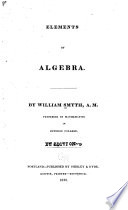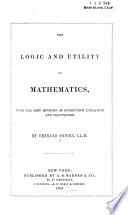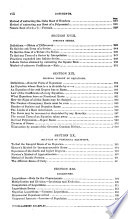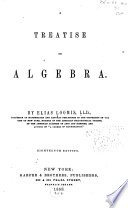 | William Smyth - Algebra - 1830 - 278 pages
...on one side the sign = in an equation are called a member ; an equation has two members. The one on the left of the sign of equality is called the first member, and the other the second. The quantities, which compose a member, when separated by the signs -f- and... | |
 | Davis Wasgatt Clark - 1844 - 394 pages
...quantities connected by the sign of equality. 152. The monomial or polynomial quantity which is written on the left of the sign of equality is called the first member ; that which is written on the right, the second member. An equation, then, is composed of two members... | |
 | Joseph Ray - Algebra - 1848 - 250 pages
...question is composed of two parts, separated from each other by the sign of equality. The quantity on the left of the sign of equality, is called the first member, or side of the equation. The quantity on the right, is called the second member, or side. The members... | |
 | Charles Davies - Logic - 1850 - 398 pages
...two quantities is expressed by the sign of equality, which is placed between them. The quantity on the left of the sign of equality is called the first member, and that on the right, the second member of the equation. The first member corresponds to the subject... | |
 | Joseph Ray - Algebra - 1852 - 408 pages
...equation is composed of two parts, separated from each other by the sign of equality. The quantity on the left of the sign of equality, is called the first member or side of the equation. The quantity on the right, is called the second member or side. The members... | |
 | Joseph Ray - Algebra - 1848 - 250 pages
...question is composed of two parts, separated from each other by the sign of equality. The quantity on the left of the sign of equality, is called the first member, or side of the equation. The quantity on the right, is called the second member, or side. The members... | |
 | Elias Loomis - Algebra - 1855 - 356 pages
...proposition expressing the equality of the quantities x—4 and b— x. The quantity on the left side of the sign of equality is called the first member of the equation ; the quantity on the right, the second member. Equations are usually composed of certain quantities... | |
 | Charles Davies, William Guy Peck - Electronic book - 1855 - 592 pages
...л and ¿. Every equation is composed of two parts, connected by the sign of equality. The part on the left of the sign of equality, is called the first member, that on the right, the second member. The second member is often 0. Equations are divided into two... | |
 | William Smyth - Algebra - 1855 - 370 pages
...equal quantities, of which an equation is composed, are called members of the equation ; the one on the left of the sign of equality is called the first member and the other the second. If a member consists of parts separated by the signs -j- and — , these... | |
 | Elias Loomis - Algebra - 1858 - 394 pages
...proposition expressing the equality of the quantities a;— 4 and b—x. The quantity on the left side of the sign of equality is called the first member of the equation ; the quantity on the right, the second member. Equations are usually composed of certain quantities... | |
| |